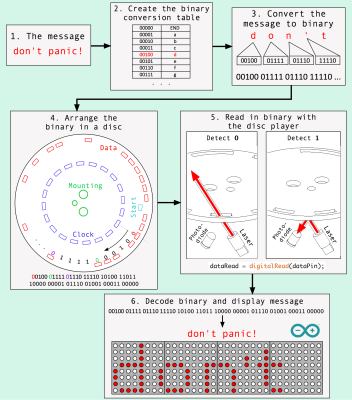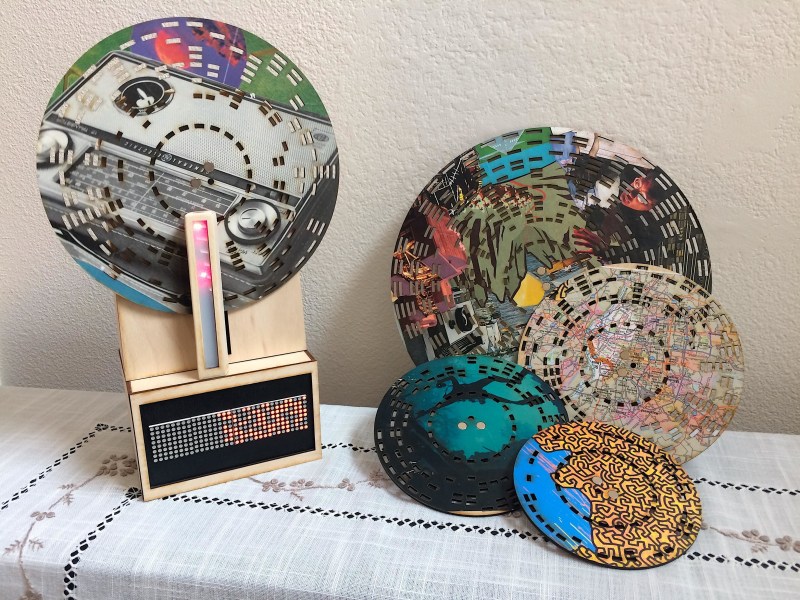
These snippets are stored in binary and read by a laser and photodiode pair that looks for holes and not-holes in the disk. The message is then sent to an Arduino Nano, which translates it into English and scrolls the text on an LED matrix. For extra fun, the Nano plays a MIDI note every time it reads a 1, and you can see the laser reading the disk through a protective acrylic shield.
Though the end result is fantastic, [jbumstead] had plenty of issues along the way which are explored in the build video after the break. We love it when people show us their mistakes, because it happens to all of us and we shouldn’t ever let it tell us to stop hacking.
If anyone knows their way around lasers, it’s [jbumstead]. We loved playing their laser harp at Supercon!
Via adafruit















This reminds me of those audio players in Dishonored.
A timing track isn’t needed if you embed the timing data within the data stream, and there are several different ways to do that. And to make things more complicated, you can use a spiral data track, additional detectors to maintain tracking, and constant-linear velocity storage. An endlessly deep rabbit hole awaits.
I wonder how the data density compares to, say, a 1 TB micro-SD card? How tall would the equivalent storage in a stack of these disks be?
Indeed. Even with a simple serial scheme of 7 bits data, one bit start, and one bit stop, you can get pretty reliable clock recovery, as long as the speed is regular enough for an adaptive algorithm to track the average clock speed.
I also think that a spiral track would be more interesting. As with CDs, this not only simplifies the mechanical design, but also packs a lot more data into an area, because the data can be arranged for a constant linear length per bit rather than a constant angular distance. That is, as you get further from the center, you can get more bits per revolution, even without any improvements in sensor resolution.
I do understand that this project is more about being a visual demonstration than anything else, but what would be more visual than seeing a spiral printed pattern on the front of the disc, where it will be seen? Yeah, I like the laminated “CD art”, but even that could be accomplished by printing the spiral in blue-green, which would be easy for the detector to discriminate, and the “art” in shades between red and yellow, which would be invisible to the red LED/detector. This is assuming the pattern is ink-jet printed and then laminated, rather than laser-cut.
Yes, of course increasing the bit density makes the mechanical tolerances more difficult, but tracking could be done using a closed loop control system. Probably the simplest of these is to incorporate two sensors, close together but radially offset on the moving “head”, so that as the spiral progresses, the lower sensor output gets stronger than the upper sensor, which would indicate a need for the tracking motor to move the head down. Essentially, the reading head then works something like a line-following robot.
I could see fitting a kilobyte or more on a disc of that size. Or maybe just 160 characters :-) .
Which is NOT meant to mean that this is anything less than an amazing project – just some ideas for the next version. Great work!
He’s built a hard sectored data disc without any timing index. 8″ and 5.25″ hard sectored floppy discs had a hole for every sector, and one index hole between two sector holes so the controller would know where the first sector of each track was.
The only major disc storage system I know of that didn’t use any kind of hard timing was the 5.25″ drives for the Commodore 64.
The Amiga didn’t use the index signal either (both 3.5″ and 5.25″ drive types.)
Then you must not be familiar with optical disc storage systems, such as Compact Disc and DVD.
Oh – I see it’s using five-bit codes. So a 5 bits data, no parity, 1 stop bit scheme would work, and this would provide a positive clock pulse for every seven bit periods, which is even easier.
I was wondering why the examples were in all lower case, but this explains it. Back in the days when every bit counted, people usually chose all upper case.
20 bits per revolution seems pretty arbitrary, and also, I would think that the bits could be placed a lot closer together. Additionally, since the detector uses reflection of the LED, it seems like laser cutting all the way through the wood was only useful for visual effect. For use in actually storing data, it should be just as effective to just burn the surface. That, or the pattern can be printed on paper, which is then laminated onto the disc.
Did anybody else notice that the tablecloth is full of holes?
Does look cool and could be a useable educational model. I like it.